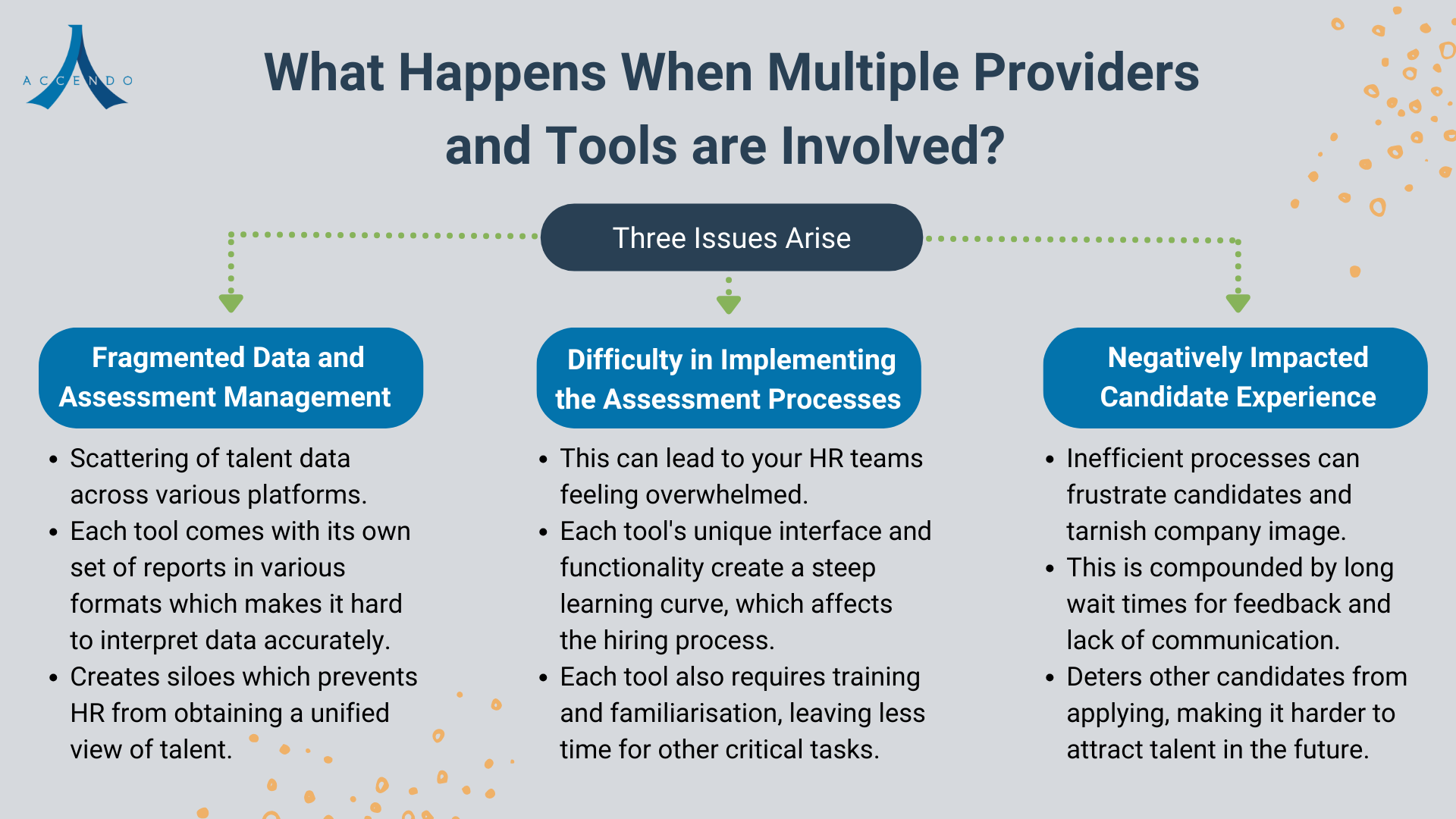Given that it can take anywhere from 3 to 12 months for a new hire, depending on their role, to really hit their stride, making the wrong hiring decision can be a huge setback. That’s why getting the right person on board is so crucial. To achieve this, companies lean on assessment tools but sometimes they overcomplicate things by using multiple providers. This can cause fragmented data sources and complex reports, inefficient processes, and a shaky candidate experience. Our article tackles these and how you can overcome them.
75% of Employers Have a Hard Time Filling Roles
The graduate employment market is evolving positively with a growing demand for graduates in areas like AI, data analytics, and cybersecurity. But the competition for skilled talent is fierce.
- A 2024 Global Talent Shortage report by ManpowerGroup states that 75% of employers are having a tough time filling various roles.
- Japan tops the list with 85% of employees struggling, followed by Germany, Israel, and Greece.
- Even in Finland, where it’s “easier,” 59% of employers are finding it difficult.
- In the U.S., 70% say it’s a challenge to find the right talent.
Companies all over the world are facing a talent shortage, and they need to adapt to stay ahead. To do this, some companies use multiple assessment tools from different providers. But it isn’t always a good idea as it can lead to inefficiency and a poor experience for candidates.
What Happens When Multiple Providers and Tools are Involved?
This approach often leads to a host of problems. The data and assessment management become fragmented, the assessment processes slow down significantly, and the inefficiency negatively impacts the candidate experience. Let’s take a deeper look into these areas.

Fragmented Data and Assessment Management
A major issue with using multiple assessment providers is the scattering of talent data across various platforms.
Each assessment tool generates its own set of reports in different formats, making it hard to interpret the data accurately. Your HR teams will struggle to piece together a cohesive picture of a candidate’s potential. This complexity can lead to misinformed hiring decisions and missed opportunities to optimise talent.
A study by Bersin by Deloitte found that organisations using disparate talent systems reported 31% less likely to identify high performers and 24% less likely to assess candidate quality effectively.
Research from PwC indicates that organisations with poor data management practices can lose up to 20% of their potential revenue due to inefficiencies and missed opportunities.
Furthermore, fragmented data sources create siloes within the company, preventing HR from obtaining a unified view of talent. This lack of integration means HR spends more time managing data than analysing it, which is a huge drain on resources.
Difficulty in Implementing the Assessment Processes
Did you know that 50% of companies take 3-4 months to get new hiring technologies up and running?
Juggling different assessment tools can lead to your HR teams feeling overwhelmed. Each tool’s unique interface and functionality create a steep learning curve, making the hiring process sluggish and inefficient. This fragmented approach delays decision-making, hampers productivity, and drives up operational costs due of resources being spread thin across multiple platforms.
Additionally, each tool requires more training and familiarisation, leaving less time for other critical tasks. This complexity can drag on the rollout, making it tough for companies to keep up with the market demands. In companies where agility matters, that’s a recipe for disaster.
Negatively Impacted Candidate Experience
A positive candidate experience is crucial for attracting and retaining talent. However, inefficient assessment processes can frustrate even the most patient candidate and tarnish your employer brand. When candidates are subjected to tedious and cumbersome assessment processes, it inevitably leads to a poor overall experience.
This frustration can be compounded by long wait times for feedback and a lack of clear communication. This negative experience can damage your company’s reputation, which can deter other candidates from applying and making it harder to attract top talent in the future.
Smarter Decisions with a Smoother Hiring Process
Hiring the right people is crucial, but juggling multiple assessment providers and tools can make the process cumbersome. Here’s how you can streamline your hiring process to make better decisions faster and improve the candidate experience.

Data and Assessment Management
Implement Integrated Assessment Platforms
Consolidating all your assessment tools and data sources into a single, integrated platform can make a world of difference. This allows for easier access to holistic talent insights which simplifies decision-making and ensures you choose the right candidates based on comprehensive information.
Alternatively, look for a vendor with an assessment marketplace – a platform that holds various assessment tools in one place. This offers several benefits:
- Access a variety of assessment tools without needing multiple vendors.
- Easy integration into your existing HR systems.
- It’s often more affordable than purchasing individual tools.
- Reduces the learning curve and streamlines the management for HR teams.
Struggling with multiple assessment tools? Imagine having all your assessment needs in one place. That’s what an assessment marketplace has to offer – a single platform with a variety of tools at your fingertips. Want to know more? Send us your questions!
Utilise Advanced Analytics Tools
Advanced analytics tools can help you break down those complex reports by:
- Seeing patterns in how your employees perform, why they leave, and what makes your hiring process work well.
- Looking at past data and growth plans to figure out what kind of talent you’ll need in the future.
- Reviewing feedback and engagement data to find ways to make your employees happier and keep them around longer.
- Finding the best places to source talent using predictive analytics and make your hiring process quicker and more efficient.
- Analysing demographic data to see where you can improve and create a more inclusive workplace.
According to a report by McKinsey, companies that leverage integrated talent management systems see a 19% increase in employee engagement and a 21% increase in productivity.
Once your HR team is good at using these tools, they can turn raw data into valuable insights.
Efficiency and Speed
Unified Assessment Platforms
A unified assessment platform can help with integrating various tools and processes into one system. These platforms often come with customisable workflows, analytics, and seamless integrations with existing HR systems, which reduces complexity, streamlines training, and enhances efficiency. You can also achieve this by partnering with a vendor that offers an assessment marketplace.
Incremental Implementation and Training
Getting new tools up and running can sometimes feel like it takes forever, but it doesn’t have to be that way. You can introduce new tools gradually and provide comprehensive training and support before moving on to the next set.
- Focus on one tool at a time so your HR teams aren’t overwhelmed by having to learn and manage multiple systems all at once.
- When training is focused on one tool at a time, your HR teams can dive deeper into understanding its features and capabilities.
- Doing this means that the day-to-day operations of your HR teams are less likely to be disrupted.
- Each successful adoption makes the team more comfortable, confident, and ready to tackle the next tool.
Candidate Experience
Enhance Candidate Experience Through Efficient Processes
A positive candidate experience is vital for attracting top talent. Streamlining your assessment processes to be clear, concise, and engaging can significantly enhance this experience.
- Simplify and Automate: Reduce the number of application stages and automate routine tasks like scheduling interviews and sending updates. This ensures a smooth, timely process with clear instructions.
- Engage and Inform: Use interactive assessment tools and provide real-time feedback to keep candidates engaged and informed throughout the process. This reduces anxiety and enhances the overall experience.
- Personalise Communication: Tailor your communication to each candidate’s journey, addressing them by name and reflecting their unique experience. Personalised messages show that you value each applicant.
When candidates have a smooth, efficient assessment journey, it builds satisfaction and a stronger employer brand. This makes your company more attractive to high-quality candidates.
Provide Transparent and Timely Communication
Communication is key in the hiring process. Ensuring that candidates are well-informed and receive prompt feedback throughout the assessment process builds trust and enhances their overall experience.
Transparency and timely communication not only make candidates feel valued but also increases the likelihood of attracting and securing top talent.
What Does This Mean for You?
Hiring great people effectively boosts everything you’re trying to do. Hiring bad, or dragging out the process, however, can slow you down and ruin your plans. A messy and inefficient hiring process can lead to bad decisions, wasted resources, and poor business performance. Using unified assessment platforms and phased training can simplify things, improve the candidate experience, and help your HR teams make quicker, smarter decisions. If your hiring process is a mess, we’ve given you the reasons why you should build a process that works and keeps working, over and over again.
Page Contents






